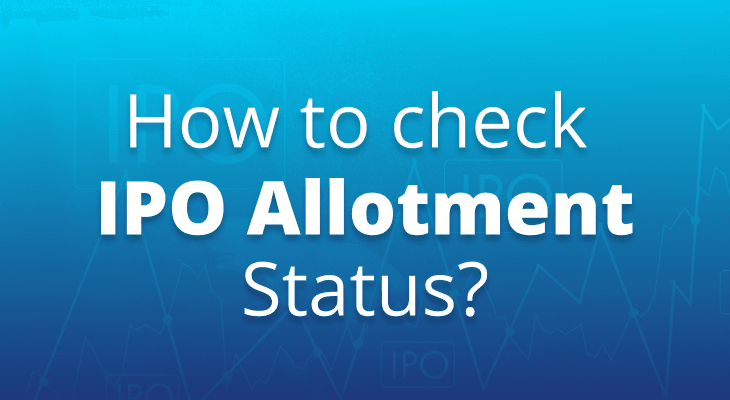
How to check IPO Allotment Status?
What is IPO Allotment?
An Initial Public Offering (IPO) is the process through which a company goes public and sells its shares to investors via a stock exchange. IPOs are launched in the primary market, and investors can apply for the shares in the public offering between the opening and the closing dates of the IPO.
IPO allotment is the process by which the shares of the company are allotted to the investors who have applied for the IPO. It is through the IPO allotment process that a company divides its shares among investors. The process is conducted according to the guidelines laid out by the Securities and Exchange Board of India (SEBI), and typically takes around 7 days.
If you have applied for an IPO, you can perform a quick IPO allotment status check online on the Depository Participant’s website or app, or via the registrar’s or the stock exchange’s website.
What is the Procedure for IPO Allotment of Shares?
The procedure for allotting shares in an IPO depends on the number of successful bids received. There may be two scenarios in this regard, and here’s how the IPO allotment process occurs in each of these cases.
Scenario 1: The Number Of Bids Is Less Than Or Equal To The Number Of Shares Offered
In this case, each investor will receive complete allotment. In other words, they will receive the exact number of lots or shares they applied for.
Scenario 2: The Number Of Bids Is More Than The Number Of Shares Offered
Here, the IPO is considered to be oversubscribed. So, no investor will receive complete allotment. Instead, the company must allot shares according to SEBI’s guidelines. In case of a small oversubscription, each investor will receive the minimum lot, and the remaining shares are proportionally allotted to investors who may have bid for more than one lot.
However, in case of a large oversubscription, it may be difficult to allot the minimum lot to each applicant. So, companies resort to the lucky draw strategy for IPO allotment via a computerized process.
How is IPO Allotment Calculated?
Share allotment in an IPO is calculated based on the kind of subscription received. Let’s take an example to understand this better. Say a company plans to issue 10 lakh shares via an IPO, with a lot size of 10 shares per lot.
In that case, the total number of lots issued will be 1 lakh (i.e. 10 lakh shares ÷ 10 shares per lot). Now, let’s take up three possible subscription scenarios and see how the IPO allotment is calculated.
If The IPO Is Undersubscribed And Receives Applications For Only 80,000 Lots
Here, each investor will receive the exact number of lots they bid for.
If The IPO Is Minorly Oversubscribed And Receives Applications For 1,10,000 Lots From 9,000 Investors
Each of the 9,000 investors will receive 1 lot of shares, so 90,000 shares will be thus allotted. The remaining 10,000 shares will be proportionately allotted to those investors who bid for more than 1 lot.
If The IPO Is Largely Oversubscribed And Receives Applications For Say 2,00,000 Lots From 15,000 Investors
Here, the calculator occurs through a computerized lucky draw process, as mentioned above.
FAQ
How are shares allotted in an IPO?
The manner in which shares are allotted in an IPO depends on the response the IPO receives from investors. If an IPO is undersubscribed, it is highly likely that investors will receive all the shares they have applied for. On the other hand, if the IPO is oversubscribed, investors will typically be allotted shares on a pro-rata basis, through a computerized process.
How to know an IPO allocation status?
You can perform a quick IPO allotment status check online using your PAN and IPO application number on the registrar’s website.
How to find out if I have been allotted shares after filling out the IPO application?
To find out if you have been allotted shares in an IPO, you need to check the IPO allotment status online, on the website of the registrar. You only need to enter your PAN and IPO application number for the IPO allotment status check.
Is IPO allotment first served?
No, the process of allotting shares in an IPO does not occur on a first-come, first-serve basis. The manner in which shares are allotted depends entirely on the response received from investors. In an oversubscribed IPO, the company allots shares based on a computerized process. And it is highly likely that you may not get all the lots you’ve applied for. However, in an undersubscribed IPO, you are more likely to be allotted all the shares you’ve applied for.
How to check if an IPO is allotted or not?
It is possible to perform an IPO allotment status check through various means. You can do this via your Depository Participant’s mobile app or website, through the website of the stock exchanges or on the registrar’s website.
What is the sure-shot way to get an allotment for the IPO?
While there is no guarantee that you will be allotted shares in an IPO, there are some things you can do to improve the chances of allotments. For instance, you can apply for the IPO early, bid at the cut-off price and apply for a smaller number of lots or shares.
How to get my IPO allotment refund?
If you are not allotted shares in an IPO, or if you are allotted fewer shares than what you applied for, you will automatically receive the refund.
How long does an IPO allotment take?
The IPO allotment process is generally completed within 7 days.
How can I increase my chances of getting an IPO?
To increase your chances of IPO allotment, you should bid early, bid at the cut-off price and avoid large applications. You can also submit several applications through multiple demat accounts.


